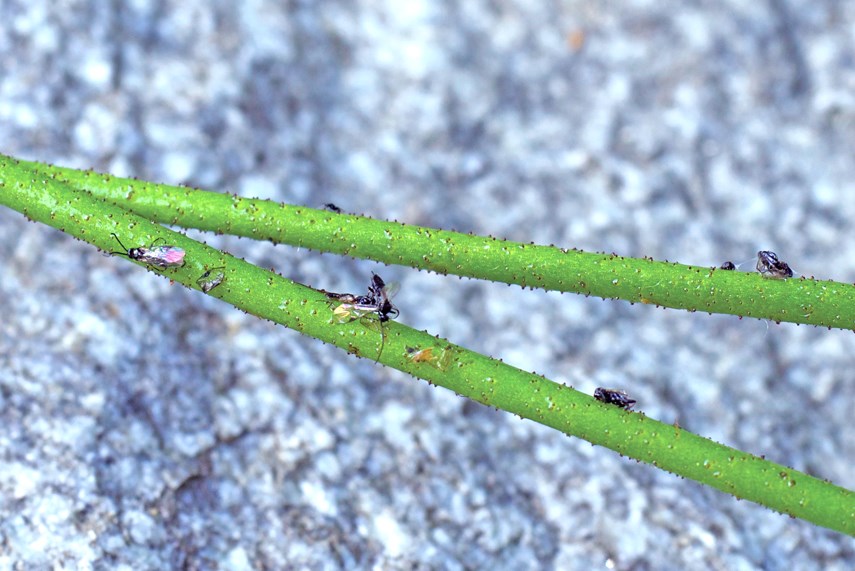
Six-leggeds beware: UBC scientists have discovered a plant common in the bogs of the North Shore Mountains that traps and digests insects.
“It’s big surprise. Many people who hike in Vancouver or B.C. will be familiar with this plant,” said Sean Graham, UBC professor and co-author of a newly published study. “No one ever thought that it was a carnivore. This is the shocking thing about it.”
Like other carnivorous plants, Triantha occidentalis, tends to live in boggy areas where the soil lacks important nutrients like nitrogen and phosphorous.
The UBC researchers had a suspicion it may be a meat eater after a previous genetic survey found Triantha occidentalis is missing a gene that often is absent in carnivorous plants. To test out the theory, the study’s lead author Qianshi Lin designed an experiment using fruit flies that had been raised in an environment full of nitrogen-15 isotopes. The flies were then humanely killed and attached to tiny hairs on the plants’ stems, which exude a sticky secretion that traps bugs.
“If the plant is carnivorous and digests the insect, which it appears to do, you can track to see if that nutrient-level nitrogen flows into the plant,” he said. “And indeed it does.”
They estimate as much as half or two-thirds of the Triantha occidentalis’ intake of nitrogen, which is a necessary for making proteins and DNA, comes from bugs, not the soil.
This is the first time a plant has been discovered to be carnivorous in 20 years. In Canada, there are now only 19 confirmed carnivorous species, and around the world, there are about 600 – a tiny proportion of our overall fauna.
“It's not every day that you have a completely new sort of instance of a carnivorous plant. This probably has evolved independently of other ones,” Graham said.
“Carnivorous plants” may call to mind David Attenborough narrating as small rodents disappear into the gaping maw of a tropical pitcher plant, or perhaps Little Shop of Horrors, a dark musical comedy about an extraterrestrial plant named Audrey II that demands human blood for its survival.
But the ones on the North Shore and other bogs along the West Coast are unlikely to devour anything bigger than a midge. The hairs on the stem simply aren’t big enough to trap larger bugs like bees or butterflies, which is likely an evolutionary strategy as the plant relies on those species for pollination.
Carnivorous plants have been a point of fascination for Western botanists and horticulturalists since the Victorian era, Graham said.
“Frankly they're a bit creepy. I mean it’s kind of ghoulish to have a plant that eats animals right?” he said. “I think that’s what gathers the attention of the public – the idea that the tables can be turned sometimes.”
While it’s anyone’s guess whether the discovery will have applicability outside botany, it will open the door to more research into the “extreme adaptations” of plants.
“We’re hoping that by looking into the genome in the future, we can actually see some of these changes and answer the question of what does it take to be a meat eating plant?” Graham said.
Lin and Graham’s paper will be published in the peer-reviewed Proceedings of the National Academy of Sciences journal this month.
“I hope it inspires other people to think about plants more and the fact that we found this basically living in Vancouver. It's pretty remarkable,” Graham said.
https://news.google.com/__i/rss/rd/articles/CBMiWGh0dHBzOi8vd3d3Lm5zbmV3cy5jb20vbG9jYWwtbmV3cy93ZXN0LWNvYXN0LWZsb3dlci1hLW1lYXQtZWF0ZXItdWJjLXN0dWR5LWZpbmRzLTQyMTA1ODXSAVxodHRwczovL3d3dy5uc25ld3MuY29tL2FtcC9sb2NhbC1uZXdzL3dlc3QtY29hc3QtZmxvd2VyLWEtbWVhdC1lYXRlci11YmMtc3R1ZHktZmluZHMtNDIxMDU4NQ?oc=5
2021-08-11 17:02:20Z
CBMiWGh0dHBzOi8vd3d3Lm5zbmV3cy5jb20vbG9jYWwtbmV3cy93ZXN0LWNvYXN0LWZsb3dlci1hLW1lYXQtZWF0ZXItdWJjLXN0dWR5LWZpbmRzLTQyMTA1ODXSAVxodHRwczovL3d3dy5uc25ld3MuY29tL2FtcC9sb2NhbC1uZXdzL3dlc3QtY29hc3QtZmxvd2VyLWEtbWVhdC1lYXRlci11YmMtc3R1ZHktZmluZHMtNDIxMDU4NQ
Tidak ada komentar:
Posting Komentar